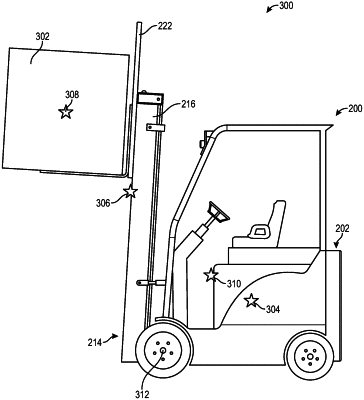| CPC B66F 9/07559 (2013.01) [B66F 9/0755 (2013.01); B66F 9/07504 (2013.01); B66F 9/24 (2013.01); B66F 17/003 (2013.01)] | 42 Claims |

|
1. A system for proactively controlling a materials-handling vehicle to enhance stability, the materials-handling vehicle being characterized by a stability polygon proximate a base of the materials-handling vehicle, wherein the stability polygon has vertices defined by vehicle geometry, the system comprising:
one or more user input devices configured to receive from an operator a request to perform an action;
one or more vehicle sensors attached to the materials-handling vehicle and configured to measure one or more conditions of the materials-handling vehicle;
one or more environmental sensors attached to the materials-handling vehicle and configured to measure one or more conditions of an environment of the materials-handling vehicle; and
a processor within the materials-handling vehicle and coupled to the one or more vehicle sensors and to the one or more environmental sensors, wherein the processor is configured to:
receive one or more vehicle values from the one or more vehicle sensors, wherein the one or more vehicle values are associated with said one or more conditions of the materials-handling vehicle;
receive one or more environmental values from the one or more environmental sensors, wherein the one or more environmental values are associated with said one or more conditions of the environment of the materials-handling vehicle;
determine, based on the one or more vehicle values, a net resultant force vector of one or more forces acting on a center of mass of the materials-handling vehicle;
determine a relationship between the net resultant force vector and the stability polygon proximate the base of the materials-handling vehicle;
create, based on (a) the relationship between the net resultant force vector and the stability polygon and (b) said one or more environmental values and before receiving a request to perform an action, one or more operational limits for the materials-handling vehicle, wherein the one or more operational limits are created when it is determined that the net resultant force vector is directed outside the stability polygon; and wherein the one or more operational limits are created when it is determined that the net resultant force vector is directed through an interior portion of the stability polygon within a predetermined non-zero distance of a side of the stability polygon;
receive, after creating said one or more operational limits, a request to perform an action; and
cause the materials-handling vehicle to perform the action within the one or more operational limits created before receiving the request to perform the action.
|